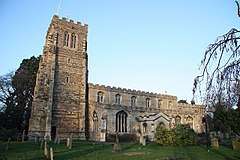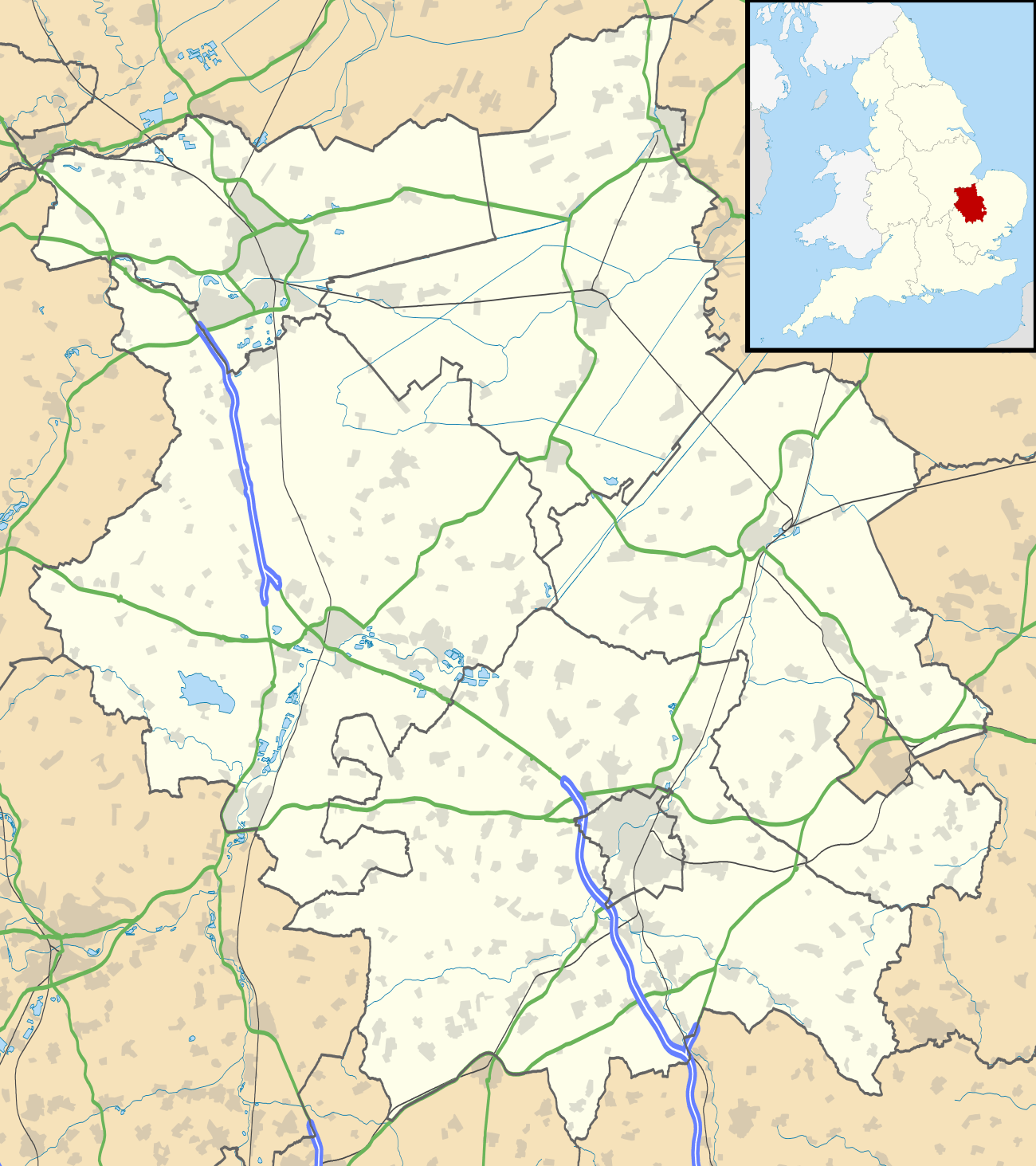Eaton Socon
| Eaton Socon | |
|---|---|
 The parish church, Eaton Socon | |
 Eaton Socon Cage, School Lane, Eaton Socon, Hunts/Cambs | |
 Eaton Socon Eaton Socon shown within Cambridgeshire | |
| Population | [1] |
| OS grid reference | TL165595 |
| District | |
| Shire county | |
| Region | |
| Country | England |
| Sovereign state | United Kingdom |
| Post town | ST NEOTS |
| Postcode district | PE19 |
| Dialling code | 01480 |
| Police | Cambridgeshire |
| Fire | Cambridgeshire |
| Ambulance | East of England |
| EU Parliament | East of England |
| UK Parliament | |
Eaton Socon is a district of St Neots in Cambridgeshire, England.[2] It was originally a village in Bedfordshire, along with the neighbouring village of Eaton Ford, but officially became part of the town in 1965. Eaton Socon changed relatively little until this time, but on its inclusion into Cambridgeshire a significant amount of development took place to the west of the village into the 1980s, with areas covering Monarch Road and the upper end of Nelson Road being developed in a particularly short space of time. The population of Eaton Socon is around 5000 people.
The village is mentioned as "Eaton" in the Domesday Book, when the manor belonged to Eudo Dapifer. In the 13th century the village became a "Soke", which meant it was independent of the local Hundred Court at Barford. In time, "Soke" became "Socon". The village was also previously known as "Sudbury".
Eaton Socon lies close to the west bank of the River Great Ouse. There is a weir (constructed in 1967) and associated lock gates to allow river navigation. The riverbank is home to a popular local inn, The River Mill Tavern. Nearby are the remains of Eaton Socon Castle.
The parish church of St Mary the Virgin stands on the picturesque green in the centre of the village. It burned down in 1930 after a fire started in the organ, but was completely rebuilt in the original style soon after. The medieval church was a 15th-century enlargement and completion of the 14th-century church. It was famous for the poppyhead bench-ends. The fire damaged the chancel less than the rest of the church so that it was possible to reconstruct its delicate 15th-century windows. The architect for the rebuilding after the fire was Albert Richardson and local craftsmen were employed.[3]
The centre of Eaton Socon is characterised by small thatched cottages along the Great North Road and side roads such as Peppercorns Lane and School Lane. Great North Road is lined with a number of local business premises. The White Horse pub dates back to the 13th century, was a Royal Mail staging post and is mentioned by Charles Dickens in Nicholas Nickleby. The village retains a great deal of atmosphere and traditional May Day celebrations are still held every year on the green.
The A1 passed through the village along the Great North Road until the Eaton Socon bypass opened in 1971. A second bypass was opened in 1985 to enable traffic travelling between the A1 and Cambridge to avoid Eaton Socon, Eaton Ford and St Neots.
For details of Eaton Socon's history, see the article History of St Neots.
Government
The second tier of local government is Huntingdonshire District Council which is a non-metropolitan district of Cambridgeshire and has its headquarters in Huntingdon. Huntingdonshire District Council has 52 councillors representing 29 district wards.[4] Huntingdonshire District Council collects the council tax, and provides services such as building regulations, local planning, environmental health, leisure and tourism.[5] Eaton Socon is a part of the district ward of St Neots Eaton Socon and is represented on the district council by two councillors.[6][4] District councillors serve for four year terms following elections to Huntingdonshire District Council.
For Eaton Socon the highest tier of local government is Cambridgeshire County Council which has administration buildings in Cambridge. The county council provides county-wide services such as major road infrastructure, fire and rescue, education, social services, libraries and heritage services.[7] Cambridgeshire County Council consists of 69 councillors representing 60 electoral divisions.[8] Eaton Socon is part of the electoral division of St Neots Eaton Socon and Eynesbury [6] and is represented on the county council by two councillors.[8]
At Westminster Eaton Socon is in the parliamentary constituency of Huntingdon,[6] and elects one Member of Parliament (MP) by the first past the post system of election. Eaton Socon is represented in the House of Commons by Jonathan Djanogly (Conservative). Jonathan Djanogly has represented the constituency since 2001. The previous member of parliament was John Major (Conservative) who represented the constituency between 1983 and 2001. For the European Parliament Eaton Socon is part of the East of England constituency which elects seven MEPs using the d'Hondt method of party-list proportional representation.
References
- ↑ Huntingdonshire District Council. "Census 2001" (PDF).
- ↑ Huntingdonshire District Council. "St Neots".
- ↑ Betjeman, J. (ed.) (1968) Collins Pocket Guide to English Parish Churches: the South. London: Collins; p. 102
- 1 2 "Huntingdonshire District Council: Councillors". www.huntingdonshire.gov.uk. Huntingdonshire District Council. Retrieved 23 February 2016.
- ↑ "Huntingdonshire District Council". www.huntingdonshire.gov.uk. Huntingdonshire District Council. Retrieved 23 February 2016.
- 1 2 3 "Ordnance Survey Election Maps". www.ordnancesurvey.co.uk. Ordnance Survey. Retrieved 23 February 2016.
- ↑ "Cambridgeshire County Council". www.cambridgeshire.gov.uk. Cambridgeshire County Council. Retrieved 23 February 2016.
- 1 2 "Cambridgeshire County Council: Councillors". www.cambridgeshire.gov.uk. Cambridgeshire County Council. Retrieved 15 February 2016.
External links
| Wikimedia Commons has media related to Eaton Socon. |
- Eatons Community Association
- Eaton Socon on the Great North Road
- www.stneots-tc.gov.uk – Contains information on Eaton Socon
- Genealogy of Eaton Socon (and Hamlets)
